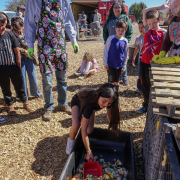Biochar Policy Project Aims to Scale Up Rural Climate Solution
By Steve Thompson, NCAT Executive Director
Dave Atkins, a forest landowner in Montana’s Blackfoot Valley, peers through the smoke-filled gloom of another hot and dry August, and he sees hope on the horizon. He’s part of a collaborative project with other small landowners, federal land agencies, conservation and watershed groups that thinks that an important solution can be found in a porous black shred of carbon called biochar.
“We’re on the cusp where biochar could really take off in the next decade. There is tremendous opportunity to form public-private partnerships that will be the catalyst to take this technology to scale,” he says. “We ‘re solving the production issues, and a market is starting to take shape. But there are some critical investments needed to jumpstart a viable biochar industry.”
Biochar is produced by pyrolysis – heating biomass such as agricultural waste or unmerchantable logging slash in the near absence of oxygen. Similar to charcoal, biochar is a porous and stable form of carbon that can improve soil fertility and water-holding capacity when added to farmlands and forest.
Atkins supports a three-prong strategy developed by the Biochar Policy Project, an alliance of landowners, researchers and conservationists led by the National Center for Appropriate Technology. The strategy addresses three critical barriers: Critical knowledge gaps on biochar must be filled. Barriers to private investment in launching the industry must be lowered. And a reliable supply chain of sustainable biomass feedstock must be developed.
He ticks off a long list of benefits to developing a robust biochar industry in the United States: It provides a market for non-merchantable slash from forest management intended to reduce wildfire risk, which otherwise would be burned. By reducing the need for slash pile burning, biochar can improve air quality.
When added to agricultural or forest lands, biochar can reduce the need for chemical fertilizers and improve crop yields on marginal land. The pyrolysis process can produce useable, renewable energy in the form of hot water, bio-fuels or biodiesel. Biochar can help stabilize toxins in mining waste and boost revegetation. Each of these environmental benefits also provide an economic boost and create new jobs in rural America.
Chuck Hassebrook, who has volunteered to coordinate NCAT’s Biochar Policy Project, highlights another major benefit. Biochar can play a critical role in pulling carbon out of the atmosphere. “Biochar’s unique promise is in providing ‘recalcitrant’ soil carbon that resists decomposition for hundreds to thousands of years. In essence, it stabilizes biomass carbon that would otherwise be decomposed in soil and released back to the atmosphere as CO2 in a few years,” he said. “Adding biochar to soils is the agricultural strategy with the highest carbon sequestration potential, which is essential if we have any hope of limiting climate warming to 1.5 degrees Celsius.”
Hassebrook says the current move in Congress to invest in infrastructure, climate solutions and rural economic development provides an historic opportunity for the government to match private investments in biochar. He notes that a growing number of corporations are investing in biochar to offset their own emissions by removing carbon from the air. For example, Microsoft’s 2021 carbon removal portfolio includes three significant investments in biochar production companies, all located overseas.
To lower capital and supply chain barriers to development of an American biochar and biofuel industry, federal matching grants should be provided for pilot, demonstration and early-stage commercial pyrolysis facilities to jump-start the industry.
To provide a reliable supply chain of sustainably harvested biomass for biochar and bioenergy production, federal funding for removal of flammable, non-commercial materials from forests at risk of wildfire should dedicate those materials to biochar production where practical.
Dave Atkins and his neighbors in the Blackfoot watershed note that there’s still a lot of research and trial-and-error learning needed to develop the technologies that meet landowner needs specific to location, type of biomass, and proximity to markets. The watershed group has been experimenting with various technologies of varying complexity and cost to determine what works best under various conditions.
While landowners and businesses are focused on the supply side of the equation, a group of leading soil scientists and biochar researchers have proposed an ambitious plan to inform the market demand side. They have developed a ten-year “roadmap” for federal biochar research, a coordinated, multi-site plan to develop fundamental understanding of the effects of different types of biochar on soil, plant and carbon processes under varying conditions, as well as regional and site-specific research to develop promising applications of biochar.
“Production needs to increase, costs need to come down, and markets need to mature. This all requires investment. Then biochar will meet the potential to solve a whole lot of problems,” said Jeff Schahczenski, NCAT’s Natural Resource Economist. “The Biochar Policy Project provides a path forward to make that happen.”
Public investment in western states already is helping develop a biochar industry as a side benefit to reducing wildfire risk. The Blackfoot watershed landowners, in partnership with The Nature Conservancy, recently received a $288,000 grant from the State of Montana Forest Action Plan to reduce the risk of severe wildfire around rural communities. About 1400 tons of unmarketable materials such as tree tops, limbs and small diameter trees, which traditionally would have been burned on site, will be turned into biochar through a pilot project using various technologies.
Biochar also received a bipartisan boost this month in Congress with the Senate’s approval of an infrastructure investment bill. Sen. Jon Tester, one of the lead negotiators who crafted the infrastructure bill, touted the inclusion of $200 million to remove flammable vegetation in fire-prone western forests for the creation of biochar or innovative wood products. “This is what Montanans expect from their elected leaders – that we work across the aisle to deliver real, lasting solutions that’ll have a positive impact on everyone who lives in the Last Best Place,” Tester said. The infrastructure bill is now being considered by the House of Representatives.
“We know all the pieces we need to make this work,” Atkins says. “Now is the time for our policymakers to embrace this sensible plan to align all the benefits and scale it up big time.”
- Related NCAT-ATTRA Publication: Biochar and Sustainable Agriculture
- Chuck Hasselbrook Opinion: One Critical Step to Limit Warming to 1.5 Degrees

 Courtesy
Courtesy
 Courtesy Carol Ann Fugali
Courtesy Carol Ann Fugali




 USDA
USDA